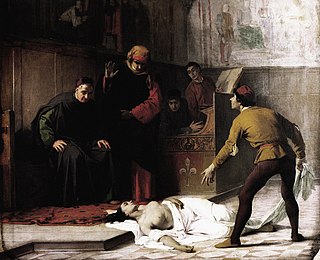
The Palazzo Pitti, in English sometimes called the Pitti Palace, is a vast, mainly Renaissance, palace in Florence, Italy. It is situated on the south side of the River Arno, a short distance from the Ponte Vecchio. The core of the present palazzo dates from 1458 and was originally the town residence of Luca Pitti, an ambitious Florentine banker.
Villa del Poggio Imperiale is a predominantly neoclassical former grand ducal villa in Arcetri, just to the south of Florence in Tuscany, central Italy. Beginning as a villa of the Baroncelli of Florence, it was seized by the Medici, became the home of a homicidal and unfaithful husband, and a lavish retreat for a Grand Duchess with imperial pretensions. Later given to Napoleon's sister, it was reclaimed by the hereditary rulers of Tuscany before being finally converted to a prestigious girls' school. During its long history, it has often been at the centre of Italy's turbulent history, and has been rebuilt and redesigned many times.

The Museum of Zoology and Natural History, best known as La Specola, is an eclectic natural history museum in Florence, central Italy, located next to the Pitti Palace. The name Specola means observatory, a reference to the astronomical observatory founded there in 1790. It now forms part of the Museo di Storia Naturale di Firenze. This museum is part of what are now six different collections at four different sites for the Museo di Storia Naturale di Firenze.

Palazzo Mozzi or Palazzo de' Mozzi is an early Renaissance palace, located at the end of the Piazza de' Mozzi that emerges from Ponte alle Grazie and leads straight to the palace where via San Niccolò becomes via de' Bardi in the Quartiere of Santo Spirito in the Oltrarno section of Florence, region of Tuscany, Italy. The 13th-century palace housed the gallery of the highly successful antiquarian Stefano Bardini, of which the remnants were left to the commune, where they assembled the Museo Bardini or Mozzi Bardini, displaying Florentine art and artifacts up to the early Renaissance. The gardens elaborated against the hillside behind the palace were added mainly by Bardini.
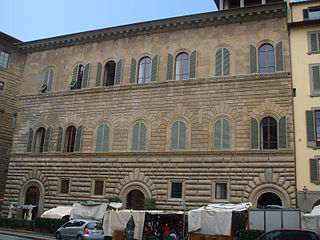
Palazzo Gondi is a palace in Florence, Italy, located a block from Piazza della Signoria. It was built in 1490 under design by Giuliano da Sangallo, who was inspired by other major works of stately buildings in the city, such as Palazzo Medici and Palazzo Strozzi. Among the elements borrowed from these earlier works are the cube-shape set around a central courtyard, the ashlar sloping on each of three floors, and the arched windows.

Palazzo Antinori is a Renaissance palace located at the north end of Via de' Tornabuoni, where it makes an odd corner with Via dei Pecori, Via del Trebbio, and converts into Via dei Rondinelli, in Florence, region of Tuscany, Italy.
The Palazzo di Bianca Cappello, originally belonging to Corbinelli family is a Renaissance-style palace located on Via Maggio #26 of the quarter of Oltrarno in Florence, region of Tuscany, Italy. It is notable for its facade decoration, and once housing Bianca Cappello, the mistress, then wife of the Grand-Duke Francesco I de' Medici

The Palazzo Nonfinito is a Mannerist-style palace located on Via del Proconsolo #12, in central Florence, region of Tuscany, Italy. Begun in 1593 using designs by the architect Bernardo Buontalenti, only the first floor was completed, and additional construction was added later by different architects. The Palace is presently the home of the Anthropology and Ethnology section of the Museum of Natural History of Florence.
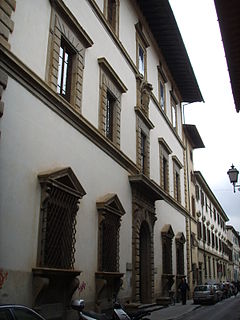
The Palazzo Giugni, also called the Palazzo Firenzuola, is a late-Renaissance or Mannerist architecture palace designed by Bartolomeo Ammanati, and located on Via degli Alfani #48 in the quartiere San Giovanni of Florence, region of Tuscany, Italy. It is located down the street from the Brunelleschi's church of Santa Maria degli Angeli.
The Palazzo del Circolo dell'Unione, also once known across the centuries as the Palazzo Corsi, Montauto, or della Commenda da Castiglione, is a late-Renaissance-style palace located on Via Tornabuoni #7 in central Florence, region of Tuscany, Italy. In 2015, it still houses the Circolo society, and houses among other enterprises, a boutique hotel.
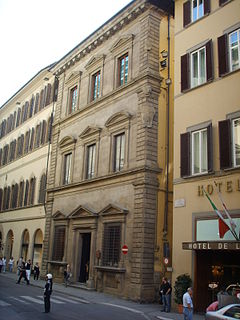
The Palazzo Larderel, once Tebalducci and Giacomini is a Renaissance-style palace, located on Via de' Tornabuoni number 19, corner via de' Giacomini 1, in the city of Florence, region of Tuscany, Italy.
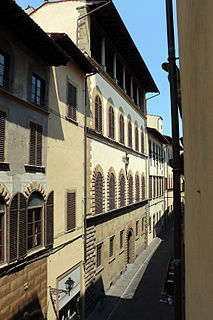
Palazzo Ginori is a Renaissance-style palace in Via de' Ginori # 11 in the Quartieri San Giovanni of the city of Florence, Italy.

The Complesso di San Firenze is a 17th-century Baroque-style building, consisting of a church, palace, and former oratory, located on the southeast corner of the saucer-shaped piazza of San Firenze, located in the quartiere of Santa Croce in central Florence, region of Tuscany, Italy. The buildings were commissioned by the Oratorians of Saint Philip Neri.
The Palazzo Tempi, also known as Palazzo Vettori or Bargagli Petrucci, is a palace located along the Arno river at the narrow Piazza Santa Maria Soprarno 1, corner with Via de' Bardi and Costa dei Magnoli in the Oltrarno section of Florence, Tuscany, Italy. The palace is across the river from the Galleria of the Uffizi, and a block east of the Ponte Vecchio. The Via de' Bardi originates in an arch under the building.
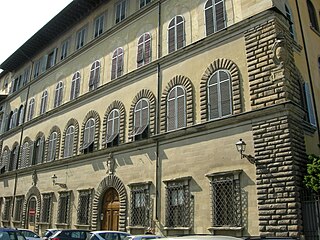
The Palazzo Torrigiani Del Nero is a Renaissance-style palace located at Piazza de' Mozzi 5, down the street where the Ponte alle Grazie enters the Oltrarno in Florence, Tuscany, Italy. Another Palazzo Torrigiani stands alongside, the smaller Palazzo Nasi. Both palaces also once belonged to the Nasi.

The Palazzo Bartolini-Torrigiani is a palace located between Via Porta Rossa and Via delle Terme, in the city block just west of Piazza Santa Trinita that includes the Palazzo Bartolini Salimbeni, in the center of the city of Florence, region of Tuscany, Italy. This portion of the block includes the medieval Torre dei Monaldi, also known as della Rognosa, rising along Via Porta Rossa.

The Palazzo Lanfranchi-Toscanelli, presently the local State Archives, is a Renaissance-style palace located on Lungarno Mediceo #30, in the city of Pisa, region of Tuscany, Italy. Since 1913 the building has housed the Archivio di Stato di Pisa.

The "workshop" of Pietro Bazzanti and Son is an historic landmark in Florence, art and culture heritage of the city. It took part in the role of "Fine Arts Trader" at the National Exposition of 1861 in Florence with several marble sculptures and various other works. The Bazzanti Marble Studio won the medal for the category "sculpture".
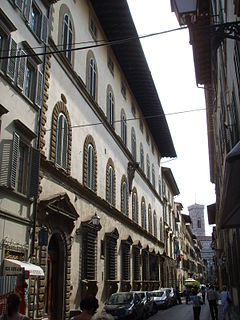
The Palazzo Gerini is a Renaissance-style palace located on via Ricasoli 42 in Florence, Italy.





